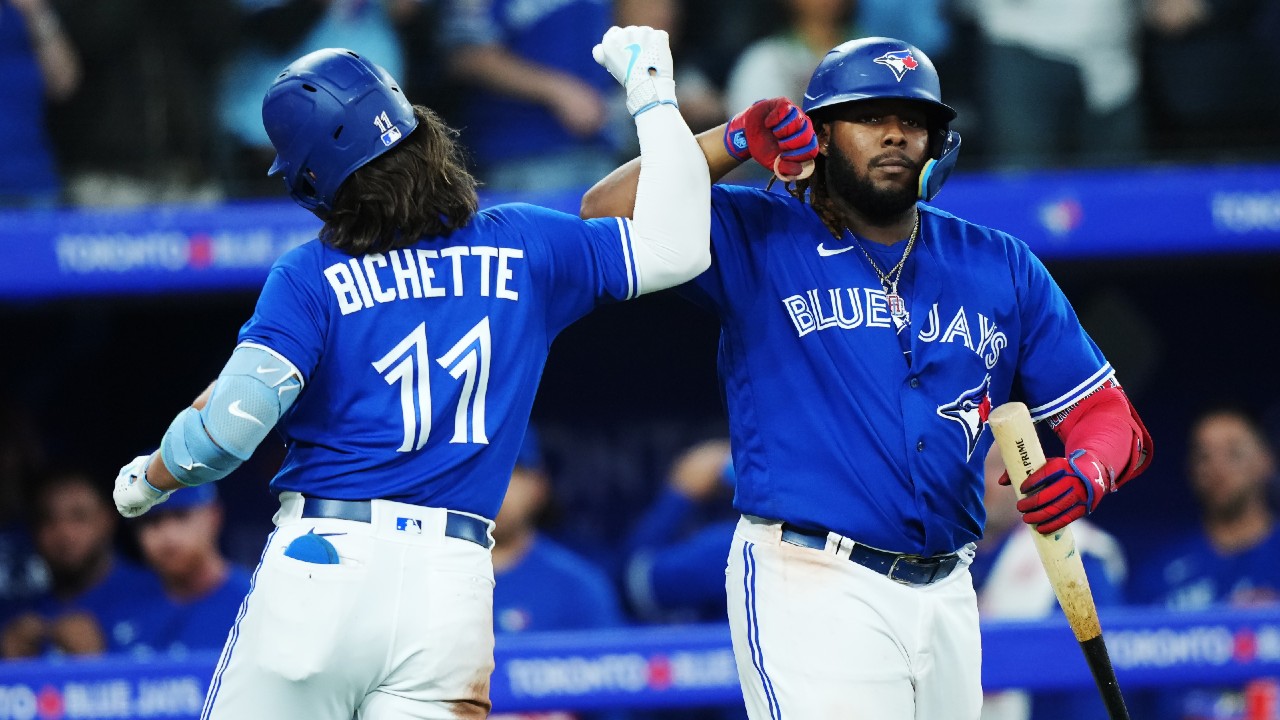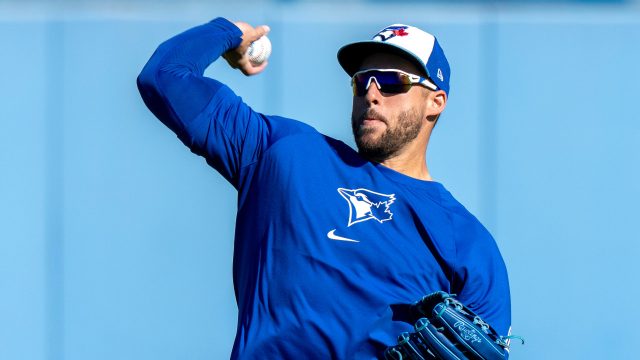The Toronto Blue Jays’ off-season has been quieter than expected, and a couple of minor-league signings before the start of Grapefruit League action won’t change that.
Adding Daniel Vogelbach and Eduardo Escobar is unlikely to radically alter the fortunes of the 2024 Blue Jays. There’s a reason the two were available on dart-throw deals this close to Opening Day. Even if the pair produces in the 90th percentile of their possible projected outcomes in the upcoming campaign, they will not be stars.
Yet, there’s a reasonable case that both of them should open the season with the Blue Jays because of their notable advantages over the incumbents.
Vogelbach’s two-game cameo with Toronto in 2020 was far from memorable, but in the three seasons since he appeared with the Blue Jays, he’s managed a 115 wRC+, with a solid 109 mark last year. Those numbers bump to 131 and 119 vs. right-handed pitching.
That’s important context considering the Blue Jays would use the 31-year-old as situational lefty thumper and shelter him from southpaws at all costs. The team projects to have at least nine right-handed position players, and Vogelbach would never need to be left in a poor matchup due to his ability to make a future defensive contribution. It’s one of the few instances where having no defensive contribution to make is handy.
Although the numbers above are not star-level for a full-time DH, they are fairly strong for a guy the Blue Jays would only deploy in favourable matchups. These numbers suggest Vogelbach has more to offer than his primary competition for the role of lefty bench bat, Spencer Horwitz.
Horwitz is coming off a stellar season at triple-A that allowed him to play 15 MLB games. In 44 plate appearances, he hit .256/.341/.385, and based on his minor-league track record and on-base ability, it’s fair to think of Horwitz as a slightly above-average hitter at the game’s highest level.
That said, FanGraphs’ collection of projection systems all like Vogelbach better for 2024:
|
Projection system |
Horwitz’s 2024 |
Vogelbach’s 2024 |
|
ZiPS |
105 |
109 |
|
Steamer |
112 |
115 |
|
THE BAT |
95 |
108 |
|
THE BAT X |
95 |
104 |
|
ATC |
110 |
106 |
|
FGDC |
109 |
112 |
These numbers are fairly close, and Horwitz arguably has more upside than a 31-year-old journeyman.
At the same time, it’s worth remembering that the homegrown first baseman is essentially a finished product at the age of 26. His high-OBP, low-power profile is also a tricky one to trust. There is a low floor for Horwitz if pitchers feel empowered to pound the zone with impunity to take away his ability to draw walks.
It’s an issue that has caused the bottom to fall out of Cavan Biggio’s production at times during his career, and his MLB ISO (.160) is better than what Horwitz managed in two runs through triple-A (.146). None of FanGraphs’ models project the first baseman to produce an ISO above .134 — a stat 114 out of 133 qualified hitters beat in 2023.
The role Vogelbach and Horwitz are vying for will call for a player to come off the bench in critical spots, and the fact the veteran is far more likely to deliver a game-changing extra-base hit than the up-and-comer should give him an edge.
Escobar’s route to a job on the Blue Jays bench is less clear cut.
For one, as a 35-year-old coming off a -0.9 fWAR season he’s on washed-up watch. It’s possible he doesn’t have anything left to give at the MLB level, and projection systems are pessimistic about him as a result. How he performs at camp and in Grapefruit League games will be meaningful because the onus is on him to prove he’s still got it.
Escobar has a little bit of history on his side, though. Multiple times in his career he’s had massive down seasons and rebounded in impressive fashion.
His age decreases his likelihood of continuing this pattern, but it’s a notable piece of his track record. Even assuming he’s not done, his road to a roster spot isn’t easy.
Of the four spots available, one needs to go to a catcher, another looks like it will be a lefty bat, and whoever from the trio of Davis Schneider, Biggio and Isiah Kiner-Falefa isn’t starting needs a spot. Schneider could theoretically find himself in a tough spot with an ugly camp, but Santiago Espinal’s position seems the most vulnerable.
Supplanting the veteran utility man is a tall order for Escobar, as Espinal has been a mainstay for the Blue Jays lately, giving the team excellent production in both 2021 and 2022. It’s possible Toronto doesn’t consider replacing Espinal with Escobar a viable way forward, but there’s an argument to be made that it should.
That starts with how the last bench spot should be used.
In prior seasons, Espinal’s ability to hit left-handed pitching and defensive ability across the infield made him a valuable player off the bench. By adding Kiner-Falefa, the Blue Jays filled their backup shortstop spot and have less need of a defence-first infielder. Espinal’s defensive effectiveness also declined significantly in 2023, and his impact on that side of the ball is tough to project for 2024.
When it comes to hitting southpaws, Escobar is probably a better option than Espinal. The veteran is a rare switch hitter who produces much more from the right side.
Although the former had a disastrous 2023, that was the result of slashing a putrid .185/.236/.270 against right-handed pitchers. In terms of hitting lefties, he’s consistently done better than Espinal in recent years.
|
Season |
Escobar’s wRC+ |
Espinal’s wRC+ |
|
2021 |
131 |
120 |
|
2022 |
128 |
138 |
|
2023 |
108 |
80 |
|
Total |
124 |
113 |
That improved production has been driven by a massive power gap as Escobar has an ISO of .229 against lefties over the last three seasons, with 22 home runs. Those numbers sit at .106 and four for Espinal.
Espinal has been better against righties, and Escobar would have to prove that his left-handed swing isn’t completely broken to challenge for a job. If he can do that in the weeks to come, he could open some eyes and minds.
In most situations, minor-league signings in February don’t play a big role for the teams they latch onto. They are generally low-downside additions who figure to provide depth if they stick around the organization they sign with at all.
Vogelbach and Escobar don’t fundamentally break the mold, but their skill sets fit well with the Blue Jays’ needs, and they might just make more sense as bench players than the team’s in-house options.
That won’t sound like an exciting prospect to fans who saw Vogelbach’s brief turn in a Blue Jays uniform — or almost anything Escobar did last year — but this pair is better equipped to break through than most players in their position.





No comments:
Post a Comment